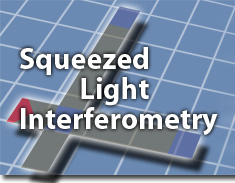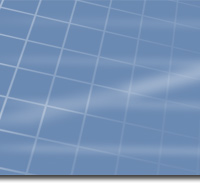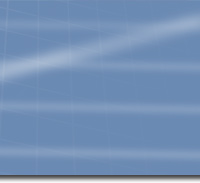 |
 |
 |
 |
| |
What we doToday's gravitational wave interferometers are not simple Michelson Interferometers but use sophisticated techniques to improve their sensitivities, e.g. power recycling and signal recycling. It has been well known for 20 years that the injection of squeezed light into the dark port could further improve the (quantum noise limited) detection sensitivity - even beyond the standard quantum limit. We theoretically proved that squeezed field injection is fully compatible with advanced interferometer techniques for third generation gravitational wave detectors [1]. In recent work we also experimentally demonstrated the compatibility of so-called power-recycling, signal-recycling and squeezed field injection [2]. Squeezed laser fields with a frequency dependent orientation of the squeezing ellipse have first been demonstrated in [3] This project is financed by the Deutsche Forschungsgemeinschaft within Sonderforschungsbereich 407, project B12. project B12. [1] Jan Harms, Yanbei Chen, Simon Chelkowski, Alexander Franzen, Henning Vahlbruch, Karsten Danzmann and Roman Schnabel: Squeezed-input, optical-spring, signal-recycled gravitational-wave detectors, Phys. Rev. D 68, 042001 (2003) [2] H. Vahlbruch, S. Chelkowski, B. Hage, A. Franzen, K. Danzmann, and R. Schnabel: Demonstration of a squeezed light enhanced power- and signal-recycled Michelson interferometer, Phys. Rev. Lett. 95, 211102 (2005) [3] S. Chelkowski, H. Vahlbruch, B. Hage, A. Franzen, N. Lastzka, K. Danzmann, and R. Schnabel, Experimental characterization of frequency-dependent squeezed light, Phys. Rev. A 71, 013806 (2005) [4] H. Rehbein, J. Harms, R. Schnabel, and K. Danzmann: Optical transfer functions of Kerr nonlinear cavities and interferometers, Phys. Rev. Lett. 95, 193001 (2005)
|
PeopleThe following students are involved in this project. Feel free to contact us!
|
Quantum noise of the electro-magnetic field is one of the major noise sources in advanced interferometric gravitational wave (GW) detectors. All first generation GW interferometers are kilometer-scale Michelson-type laser interferometers with suspended mirrors. The interferometer output port is locked close to dark fringe and a gravitational wave that excites the anti-symmetric arm length oscillation leads to a modulated output field. A nice overview on GW laser interferometers is given in [1].
Two ways of how quantum noise affects the measurement need to be considered: Shot-noise arises from uncertainty in the phase quadrature of the interferometers internal field and manifests itself in quantum fluctuations in the number of detected photons at the interferometer output. Radiation-pressure-noise arises from uncertainty in the amplitude quadrature of the interferometers internal field. This results in an uncertainty in mirror positions. Whereas shot-noise of a coherent state has naturally a white spectrum, radiation-pressure-noise falls off with increasing sideband (detection) frequency. The sum in quadrature of both contributions leads to the interferometers total quantum noise (assuming no correlations between phase and amplitude quadratures). By varying the laser power one contribution can be lowered on the expense of the other obeying the Heisenberg Uncertainty Principle. For any laser power the total quantum noise shows a minimum at a specific frequency. The frequency dependent minimum, or in other words, the spectrum of minima defines the interferometers so-called Standard-Quantum-Limit (SQL) which has long been thought to describe a fundamental boundary for measurement sensitivity. During the last decade it has been shown that quantum correlated light (squeezed/nonclassical light) is able to beat SQL performance. This is the new field of Quantum-Non-Demolition - Interferometry.
Vacuum fluctuations offer a convenient model to understand the effect of quantum noise of the electro-magnetic field. Vacuum fluctuations enter the interferometer from its dark output port. Similarly to the laser beam these vacuum fluctuations are back reflected, beat with the signal field and contribute to the measurement noise floor. Furthermore the beat with the internal laser field indeed excites the anti-symmetric arm length oscillation accounting for the phase relations at the beam splitter. From this consideration it becomes clear that the ordinary vacuum at the dark port needs to be replaced by a squeezed vacuum in order to change the quantum noise properties of the Michelson interferometer; quantum noise entering the bright port does not contribute to the noise floor. It becomes also clear that desired squeezed vacuum states should be amplitude squeezed at low frequencies where radiation pressure noise is dominant and phase squeezed at high frequencies. Here the reference is given by the internal laser field. A vacuum state with a smoothly rotating squeezing ellipse along the spectrum then provides the desired broadband quantum noise reduction, which is only limited by the squeezing factor applied. Noise spectral densities below the SQL are possible. Note that we have assumed detection of the phase quadrature which carries the strongest GW signal. It is possible to choose any other quadrature for detection, even in a frequency dependent way (so-called variational output). It turns out that opto-mechanical coupling between the laser field and mirror masses lead to ponderomotively squeezed states and can turn the interferometer into a QND-device. In such devices the radiation-pressure noise (back-action noise) cancels, also allowing for sub SQL performance. [1] N. A. Robertson, Class. Quantum Grav. 17, R19 (2000), Laser interferometric gravitational wave detectors. [2] H. J. Kimble, Y. Levin, A. B. Matsko, K. S. Thorne and S. P. Vyatchanin, Phys. Rev. D 65, 022002 (2001), Conversion of conventional gravitational-wave interferometers into quantum nondemoltion interferometers by modifying their input and/or output optics. Roman Schnabel, 29/Sept/2004 Theoretical work of this project is done in close
collaboration with Dr. Yanbei Chen from
our partner institute at Golm ( Potsdam ). |
website by AF//c:2k+4; RS//May 2007 |